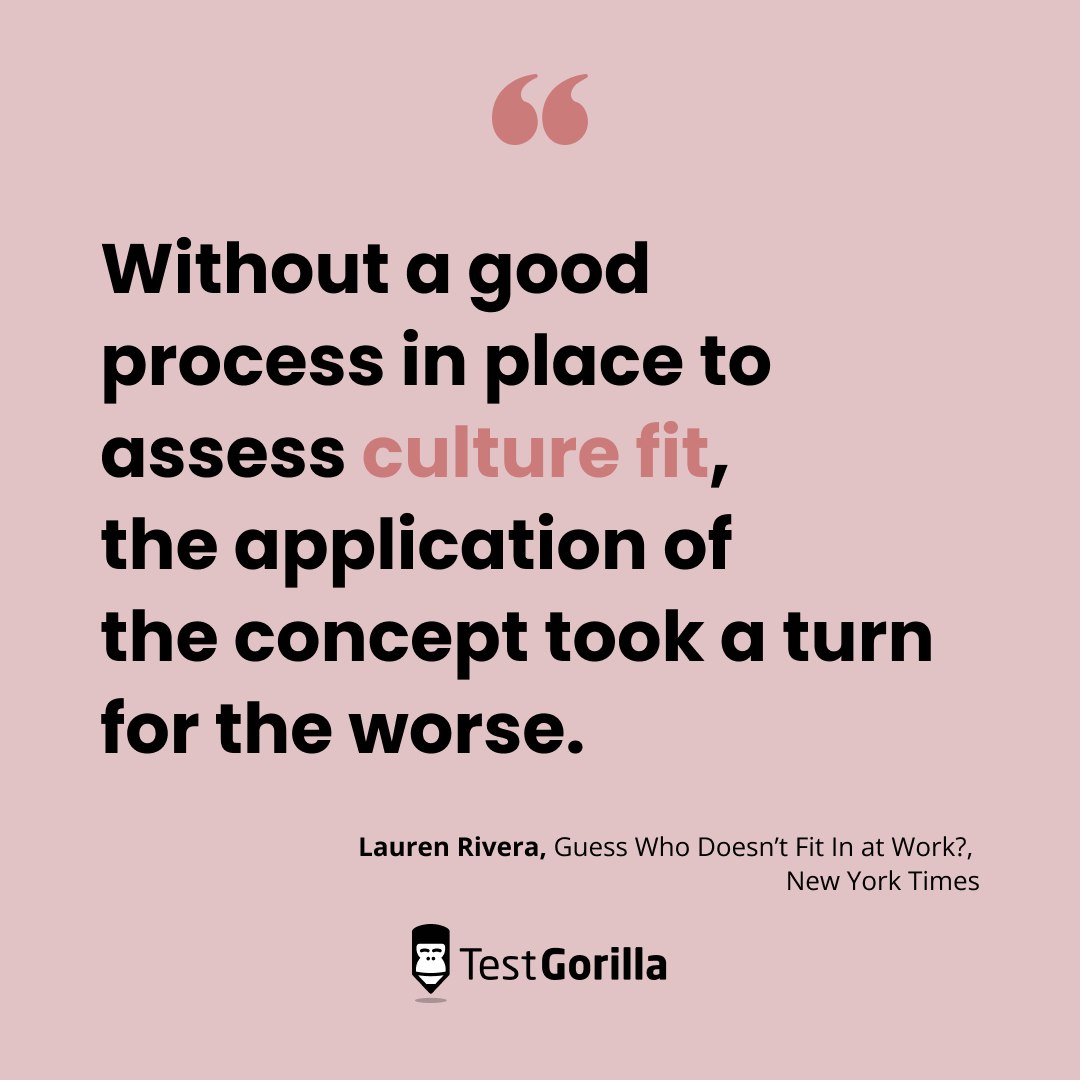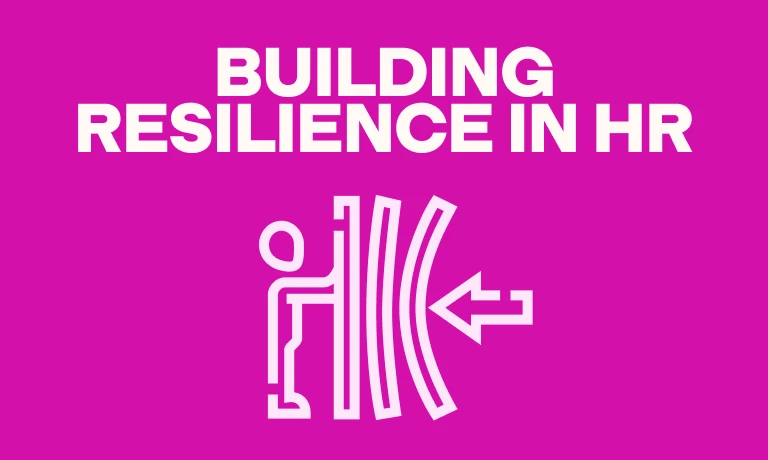The culture add test: bringing objectivity to “hiring for culture”
Nearly four decades after the first variant of the adage “culture eats strategy for breakfast” appeared in print, there seems to be no consensus in business circles on how to hire for culture—or even if you should at all.
The challenge is that culture is not a tangible thing. Culture is a set of values that a team holds collectively (whether consciously or unconsciously) and is expressed in the behaviors and actions that individuals members of that team take on a daily basis. As such, culture has been historically hard to define in an objective and quantifiable way that could be leveraged for hiring.
At TestGorilla we’ve created a test to help you do just that: hire for culture in an objective, measurable, and repeatable way. We call it the culture add test because it helps you identify and hire individuals who can thrive at your organization and make positive contributions to its culture.
Before we dive into our test and how it works, let’s look at the main objections that have been raised against hiring for culture and how the phrase “culture fit” in particular became a loaded term.
How culture fit became a loaded term
Patty McCord, Netflix’s Chief Talent Officer from 1998 – 2012 has advised companies to stop hiring for culture fit. Facebook has outright banned the term from its hiring processes. Why such extreme retaliation against considering culture fit during hiring?
Because culture fit “has gone rogue,” as Lauren Rivera put it in a New York Times piece.
Rivera traces the origins of the term “culture fit” to Jenifer A. Chatman’s paper on person-organization fit. Chatman defined “person-organization fit” as “the congruence between patterns of organizational values and patterns of individual values” and concluded that such a fit can increase job satisfaction and tenure.
The business world, eager to make better hires, improve teams, and increase both employee commitment and satisfaction, quickly took to the idea. But without a good instrument and process in place to assess culture fit, the application of the concept took a turn for the worse.
An individual’s personal values became equated to the individual’s personality traits, hobbies, and social interests. And the organization’s values slipped into the hiring manager’s cultural experiences, educational background, and social preferences.
Over time, the “fit” moved away from a congruence of values and became about “fitting in” socially as determined by the hiring manager’s “gut feeling” about each candidate. And “culture” became about cultural frills like ping-pong tables, bean bags, free coffee, and other perks that companies (particularly Silicon Valley tech companies) began offering to employees and which had little if anything to do with the deeper values of workplace culture.
Eventually “culture fit” boiled down to one question: “Would I want to grab beers with this person after work?” If not, they don’t “fit” (in). “Culture fit” became code for allowing bias (both explicit and implicit bias) to shape the hiring process.
This interpretation of culture fit is a far cry from the original meaning of Chatman’s person-organization value fit. Understandably, the chasm between the two meanings has made “culture fit” a divisive term among recruiters and HR professionals.
Those who still advocate for “culture fit” caution that it must be used properly. But given the baggage the term has accumulated over time, many companies and hiring professionals advocate for a new, more flexible, and more inclusive term: culture add.
Let’s explore what hiring for “culture add” brings to the equation and how it helps companies move past the limiting aspects and misunderstandings of “culture fit.”
From culture fit to culture add: what you should be hiring for
The rising demand for Diversity & Inclusion officers reflects the growing importance of these issues for organizations. Corporate culture is no longer about “fitting in” but about creating an environment where diverse employees can feel included and make valuable contributions.
But “culture fit” has not been discarded entirely. In the move from “culture fit’ to “culture add,” companies continue to highlight the importance that “culture” plays in building successful teams. So what does “hiring for culture” mean at its basic level and why is it important?
The importance of “hiring for culture”
Hiring for culture is the practice of hiring based on an alignment of values—a congruence of values, as Chatman called it in her paper.
Values are the foundations of a company. They are the pillars on which the company grows and develops and the operating principles that determine how a company does what it does.
Meta-analyses of various studies about an individual’s fit at work published by Kristof-Brown et al. in 2005 have shown that better alignment between an employee and the organization leads to higher job satisfaction, greater commitment from employees, and longer tenures.
Hiring for culture means evaluating whether the values of candidates align with the values of the organization in order to hire employees who can thrive in that organization and positively contribute to the team as a whole.
Culture, diversity, innovation: can companies have it all?
Can companies hire for culture while increasing diversity and innovation? Absolutely. In fact, companies must hire with an eye to all three—culture, diversity, and innovation—in order to benefit from any of them individually.
In their Harvard Business Review article “Diverse Teams Feel Less Comfortable—and That’s Why They Perform Better,” David Rock, Heidi Grant, and Jacqui Grey emphasize that for diversity to work it must be underpinned by common values.
“Diversity is not a panacea and it can at times produce corrosive conflict. When that happens, it is often because team members are bringing different values, rather than different ideas, to the table. It’s difficult to overcome differences in values, no matter how well-intentioned colleagues may be.”
“Diverse Teams Feel Less Comfortable—and That’s Why They Perform Better,” Harvard Business Review , by David Rock, Heidi Grant, and Jacqui Grey
Studies have shown that diverse teams are more innovative and achieve better business results. They:
make more objective decisions
encourage and challenge each other more often
process information more carefully
innovate quicker
earn higher profits
Hiring for culture should be based on a congruence of values, not on how well a candidate reflects the interviewer’s own beliefs and preferences, a common pitfall called “looking-glass merit.” And when hiring is rooted in values, it will help boost both diversity and innovation at your company.
Evolving your culture with purposeful additions
Your company’s culture is a living thing that shifts and grows along with the organization. Trying to maintain your culture by hiring people who “fit” into it can stifle your company’s growth. What you want to do instead is evolve your culture through purposeful additions that can enhance your growing team.
A study done by Jim Barron and Mike Hannon at Stanford University showed that hiring for “culture fit” helped early-stage startups succeed at higher rates than startups that didn’t prioritize fit during hiring. But once those startups reached IPO, their performance declined and they grew at a slower pace than other companies. The startups that had focused on culture fit lacked the diversity and innovation factors that help growing teams perform better.
Organizational psychologist Adam Grant points out that the issue lies precisely in the “fit.” The first employees at a small startup, by default, set the values that will form the basis of the culture. And when there’s an alignment of values among the early employees, the team does well. When the startup tries to replicate its culture as it grows by hiring people who “fit,” it begins to generate groupthink and stunt its own development.
What growing companies should look for instead, Grant says, are “originals.” They should be looking for individuals who can contribute behaviors and activities that can help shape the company and its culture into a new and improved version of itself so it can reach bigger goals.
This doesn’t mean you should abandon your core values or stop evaluating whether candidates share those values. Your company values are your foundation, and unless there’s a radical change in the company, they always will be. What you want are purposeful “additions.” You want to “add” the elements—the behaviors and activities—that will help improve your core culture.
Hiring for “culture add” maintains the importance of hiring based on an alignment of core values while highlighting (and reminding us of) the importance of new contributions in nurturing a healthy, diverse, and innovative culture as we grow.
That’s probably why companies like Pandora, Greenhouse, and Lattice have fully embraced the concept of “culture add” in their hiring processes.
The best insights on HR and recruitment, delivered to your inbox.
Biweekly updates. No spam. Unsubscribe any time.
The difficulty of hiring for culture add
The concept of “culture add” marks a great improvement in how we think about hiring. But how do we put it into practice?
Hiring for “culture add” presents some of the same risks as hiring for “culture fit.” As we’ve seen, the “culture” part of both terms requires companies to hire based on values. While “what” needs to be done is clear, there has never been a good process for “how” to do it—until now.
Chatman advised in her 1991 paper that both organizations and individuals should gather information on each other’s values before making a hiring decision by “perhaps asking questions” that reveal those values.
When “culture fit” started going “rogue,” those questions devolved into the “beer test,” what music you listen to while driving, and other questions aimed at superficial and irrelevant information. With the reevaluation of “culture add,” those questions have evolved into structured interview questions that aim at understanding candidates on a deeper level.
Holding structured interviews means that the hiring committee determines what they’re looking for in an ideal candidate beforehand and constructs questions to evaluate candidates based on those requirements. Greenhouse ATS has even added a special section on its scorecards for “culture add” interviews where hiring teams can list values to evaluate and take notes on candidate responses.
While helpful, relying on interview questions makes it hard to measure alignment in a consistent way. Data from interviews is qualitative in nature and often influenced more by the interviewers’ impression of the candidate than the candidate’s own values or behaviors. What’s more, notes taken during interviews cannot be reviewed, evaluated, and ranked in an objective and measurable way.
Let’s consider two famous optical illusions to illustrate the point.
What color are the hearts in the image below?
Correct answer: they’re all the same color. Your brain, however, interprets the color value of each heart differently based on its immediate context.
Image source (modified)
A similar effect can take place cognitively when we try to gauge values through questions and answers. Each interviewer and candidate can interpret a question or answer about a specific value differently based on their previous experiences with that value and their personal experience during the interview.
Things only get more complicated when interviewers compare notes from different candidates. What they see resembles the famous “café wall” illusion.
Image source (modified)
All the lines are parallel, but because the measuring units don’t line up precisely to begin with, the viewer perceives a topsy-turvy image instead.
Qualitative data from interviews can be great when you want to dig deeper and better understand specific points about your candidates. But without an objective base to start from, they can lead you astray.
As Joeri Hofmans and Timothy A. Judge put it in their Harvard Business Review article, “you can’t determine culture fit [or culture add, in our case] without proper measurement. This consists of three steps:
First, you need to measure the actual values of the organization or team. This is done by measuring the values of each employee in the organization or team using a standardized value instrument.
Second, because the goal is to compare the candidate’s values to those of the organization or team, the value assessment of the candidate should be done using the same standardized instrument.
Third, you want to objectively compare the candidate’s value profile with that of the overall organization or team. Using algorithms can help minimize bias at this step.”
At TestGorilla, we’ve built precisely this measurement tool to help you define, measure, and determine the alignment of values and behaviors between your organization and your candidates so you can hire for culture add reliably and objectively. Let’s see how it works!
The TestGorilla culture add test: hiring for culture add objectively
To measure something objectively you need a standardized measure against which to evaluate it. To measure many things objectively, you need to evaluate all of them against the same measure and compare the results.
That’s no revelation. It’s the reason we have things like rulers, scales, and standard cup sizes. It’s also the reason we offer skills tests at TestGorilla. A candidate’s years of experience can’t reveal how skilled the candidate is in an area and how skilled they are in comparison to other candidates. A standardized skills test can.
The TestGorilla culture add test does the same thing but for your culture. It begins by setting the standard for your culture through a questionnaire you complete and then uses the same instrument to measure your candidates’ alignment.
The test evaluates alignment on two parameters:
Values: We measure how each candidate’s personal values align with your organizational values.
Behaviors: We measure how the behaviors each candidate exhibits within their role align with the behaviors you’re looking to bring to your team through the specific role.
The first part of the test helps you build a strong foundation by measuring the alignment of values between your organization and your candidates. The last part helps you determine and evaluate the behaviors that will round out your team and its current culture into a more diverse and innovative group.
How the test measures values and behaviors
To measure the two parameters for the culture add test and set a standard for your candidates, we give you a list of relevant words in each category and ask you to rate their importance on a scale of one to five.
We then give each candidate the same lists of words (without showing them your scoring) and ask them to select the 10 words from each category that most apply to them. Once candidates submit their selection, they are automatically scored based on the ratings you provided. Then you can see how well candidates align with your organization.
In addition to overall comparison scores, you can also see the specific words each candidate chose, so you can discuss their choices and what they mean to them at a deeper level during a culture add interview to understand why the candidate made certain choices. These discussions can provide additional context about how candidates align with your team and the contributions they can make to your culture.
Values apply to your entire organization and you should keep the same ratings across all your roles.
Examples of values include:
Achievement
Equality
Independence
Many of the values on our list will not match the exact words you use to define your company values, but that’s totally fine. In fact, it can actually benefit you, as candidates won’t be able to quickly guess your 10 most important values based on your company website.
Behaviors relate to how candidates approach their work and what you consider essential for success in a particular role.
Unlike values, desirable behaviors will vary from role to role based on the needs of the role and the current composition of the team.
Example traits include:
Analytical
Diligent
Helpful
By screening candidates for particular behaviors from role to role (and defining those behaviors in advance), you can identify and interview a diverse roster of employees. That’s because when you look at behaviors in a standardized way across your candidates, you avoid subjective assessments and assumptions based on factors like background, race, ethnicity, gender, and other parameters that could (unconsciously) influence your evaluation of a candidate.
Similar to behaviors, interests can be prioritized based on the current composition of the team. For example, if you have a team of hands-on doers, you can balance the team out by hiring someone who prefers to tackle strategy.
Rating what you’re looking for in a new team member across the parameters of values and behaviors will allow you to define both the core of your culture and the additions you’re looking to bring into it through your new hire.
Maintaining objectivity in culture add measurements
A standardized measuring tool solves half of the objectivity problem in measuring culture add—or in measuring anything for that matter. The other half of the objectivity problem lies not in the instrument, but the humans using the instrument.
Despite our best intentions, there are two things that can make us lose our objectivity: implicit bias and the desire to please. The way we’ve set up the culture add test helps you guard against both.
Preventing implicit bias. Standardized instruments can’t help us get to objective answers if we’re applying double (or even multiple) standards in reading the results. Double standards can creep in through implicit bias. We don’t want or intend to judge candidates differently, but some detail about them (their age, their ethnicity, their gender, their brand of shoes, or anything really) leads us to make an unconscious decision about them that can affect how we interpret what they say and how they perform.
To prevent implicit bias, we ask you to complete the questionnaires for determining and measuring the values, behaviors, and activities you’re looking for in candidates before you meet any of your candidates or see any of their results. This helps keep your evaluations objective and allows you to assess each candidate based on their score, not your perception of them based on external factors.
Overcoming a candidate’s desire to please. Candidates want to impress you. They want you to like them and offer them the job. While enthusiasm is great, excessive eagerness to please can do a disservice to both you and the candidates because it doesn’t allow you to gauge alignment of values properly.
When candidates take the culture add test as part of their application to your company, they can’t give you “ideal” answers based on how you respond to them in a conversation or what they gauge about you and your company during an interview. This allows you to keep their desire to please in check so that you can make a more objective assessment of what each candidate will bring to the role.
Additionally, the time limit of the test—candidates have 10 minutes to complete it—helps keep them on track and keep them honest. They don’t have time to research your company in an attempt to figure out which values, behaviors, or activities you may have chosen. Besides, their invitation to the assessment doesn’t specify which tests are included, so they can’t really prepare for it.
Even if a candidate attempts to research your company on the spot, our platform’s anti-cheating mechanisms are likely to prevent them from doing so. The software tracks when candidates leave the test window and takes random pictures of candidates during the assessment that show if they’re using hand-held devices for research.
With these measures in place, you can review and evaluate your candidates’ results objectively, knowing that each person has answered as honestly as possible.
Start hiring for culture add today
A strong culture that evolves and grows with your company can make the difference between the success and failure of your organization.
The culture add test helps you find candidates who share your organization’s core values and who bring the behaviors that matter most for growing your team. Focusing on the combination of these core elements will keep you from basing your evaluation on extraneous factors that can introduce bias and contribute to your company’s diversity, innovation, and overall success.Sign up for a free trial to use our culture add test in your candidate assessment, or schedule a demo to have someone on our team walk you through the process.
You've scrolled this far
Why not try TestGorilla for free, and see what happens when you put skills first.

















